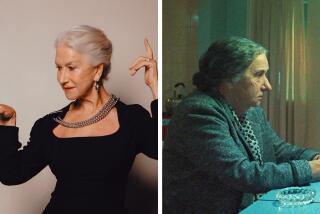Dental Flaws : Why Imperfect Teeth Are Often Behind the Most Charming Smiles
ACCORDING TO dentists and orthodontists, a “perfect” smile is never perfect. Many specialists, who make a career of bonding, capping, bleaching, filing and straightening teeth, encourage their patients to opt for teeth that are slightly flawed.
To this end, one Beverly Hills dentist actually adds subtle tobacco stains to new teeth if the patient smokes.
Another dentist refuses patients whose flaws are too minor. “Some people would ruin their smiles by trying to improve them,” he says.
Many dentists agree with Dr. Steven Goldy of the USC School of Dentistry, who says: “There are personality and charm in an imperfect smile.”
Indeed, for many celebrities, imperfect teeth have become part of their images. Singer Carly Simon has a pronounced overbite that she displayed in a tight close-up on the back cover of her “No Secrets” album. Actress/comedienne Whoopi Goldberg’s trademark is her short, dreadlock hair style, but she’s also known for her unevenly spaced, prominent teeth. In the movie “Moonstruck,” actor Nicolas Cage’s crowded lowers drove more than a few dentists crazy, but they didn’t get in the way of his performance as Cher’s passionate suitor. Talk-show host David Letterman, leading man Arnold Schwarzenegger and actress Lauren Hutton all have a median diastema--a space between the front teeth. As one of the top fashion models of the ‘60s and ‘70s, Hutton wore a temporary dental cap, but now she tends to flaunt her natural smile. In his book “Scavullo on Beauty,” photographer Francesco Scavullo titled his section on Hutton “Nobody’s Perfect” and opened it with a casual portrait of the actress flashing a gap-tooth grin.
But for many people with seriously problematic teeth, even an artificial, piano-key look is preferable. For them, aesthetic dentistry is a godsend. Dentists have been changing smiles with dental caps for decades. “Today, because of technical advances, aesthetics is the fastest-growing area in dentistry,” says Dr. Irwin Smigel, president of the American Society for Aesthetic Dentistry in New York.
In one of the field’s newest developments, cosmetic dentists have begun using porcelain veneers, a method in which porcelain is actually laminated to the front and side teeth.
This method is expected to eventually replace bonding, a technique developed in the early ‘70s to close spaces between teeth or repair chipped or rotated teeth and cover stains.
But according to Smigel, who helped develop the bonding technique, “porcelain is the wave of the future.” Unlike the acrylic resins used in bonding, porcelain doesn’t stain. It is stronger and lasts “at least 10 years. But it could last indefinitely,” says Smigel. The big plus, he adds, is that “porcelain looks more natural.” The negative is that the process is irreversible, because it’s necessary to remove about one-third of the tooth’s enamel before the veneer is applied.
Yellowing is the most common complaint aesthetic dentists hear. “People are beginning to realize that it’s our teeth, not our skin, that first start to give away our age. As we get older, our teeth get yellower,” says Beverly Hills dentist Roger Lewis.
Veneers or bleaching with a strong peroxide solution are the newest corrective procedures, Smigel says.
Again, though, dentists urge patients to be realistic about improving the appearance of their teeth. Dr. Bradley Baum, associate clinical professor of orthodontics at USC, says the perception of “perfect teeth” is “straight, white and all the same length. That doesn’t occur naturally.”
Goldy adds, “For most people, the kind of ‘perfection’ that certain performers have isn’t desirable. The teeth look obviously capped.”


